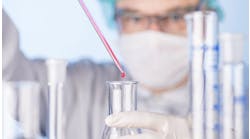By Paul Thomas, Senior EditorFrom the Thermo Fisher Scientific press conference at Pittcon 2010 (held March 1), it was clear that Thermo has not let the global recession slow it down, and in fact has taken the opportunity to leverage its size and strength to improve its positions in several market areas. Thermo President and CEO Marc Casper began the press conference by reminding the audience just how large and expansive the conglomeration of Thermo Scientific and Fisher Scientific is: currently with $10 billion in annual revenues, and 35,000 employees in 40 countries. In addition, 2010 has been “a breath of fresh air” compared with the business environment of 2009, he noted. Life sciences represents 50% of the company’s business, with Healthcare another 24%, Casper said. North America represents 61% of total revenues, but at 11% Asia (and primarily China) is its fastest growing market.“Nobody has the scale that we have, or the breadth of portfolio,” he noted. Business focuses now include:• Analytical instruments• Laboratory products• Specialty diagnostics• Customer channels• Biosciences• BioPharma ServicesThe company will continue to invest heavily in all areas to develop new products. “Despite a tough economy, we will be increasing our R&D by $30 million this year,” Casper said, “and expect $50-$150 million from stimulus funding, primarily in the U.S.”Acquisitions continue to play a large role in Thermo Fisher’s growth plans. Recent transactions include:• Ahura Scientific: Ahura’s handheld spectrometers “bring chemical analysis in addition to the elemental analysis we already have with our Niton analyzers,” Casper said.• Finnzymes, which expands Thermo’s molecular biology portfolio• B.R.A.H.M.S., which increases its offerings in diagnostic biomarker tests• Biolab, which extends its Australian and New Zealand supply chainNext, Thermo Fisher’s Ian Jardine, VP of global R&D, discussed new products being introduced at the show: High-end Research: Two new products in this area are upgrades to the LTQ Velos mass spectrometer, and hybrid ion trap/mass spec LTQ Orbitrap Velos. The LTQ Velos and Orbitrap are used in pharma for looking at the structure of new drug metabolites. In particular, with Orbitrap combination product, “Scientists have been able to analyze tens of thousands of proteins in the span of just a couple days,” Jardine said. The current generation of these products is much faster and more sensitive than before, Jardine noted, and now can identify and quantify four or more times the number of proteins that a QTOF could.Routine Testing: Among four new chromatography products introduced at Pittcon was the Accela 1250 U-HPLC Pump. Customers have a wide range of flow rates, which can cause baseline drift, Jardine noted. The Accela 1250 allows for more stability in pump flows. General Lab: The Orbiter is a fast, compact robot for pharma screening, accompanied by Momentum software. All of the electronics of the robot are in the tower console, making it a single unit. And the Orbiter is significantly cheaper than previous robotic screening systems. “This is a phenomenal breakthrough in affordable robotics,” Jardine said.With LIMS-on-Demand, Thermo has entered the market of web-based, on-demand products. “Basically, the user doesn’t have to buy the hardware or software,” Jardine noted. “It’s all done over the Internet, and the business model is all by subscription. A lab’s ability to get up and going with a new LIMS system is effectively instantaneous.” It’s a reliable and secure LIMS that will appeal to laboratories with fairly conventional needs and that do not want the upfront investment required from a traditional LIMS, Jardine noted.Field: The Niton XL2 Handheld Analyzers are actually a simplified version of Thermo’s higher performance XL3 for field-based metals identification. “This is a response to a customer need” for routine analysis in a less-expensive device, Jardine noted. FirstDefender RMX: From the Ahura purchase, this is the next generation in Raman instruments for field-based chemical identification—a complement to the Niton line. This is 50% smaller than the previous Ahura unit, and five times faster. And it’s robust, Jardine pointed out. “You can take the unit and drop it on concrete 20 times and it will still work, or you can run it under water,” Jardine said.


